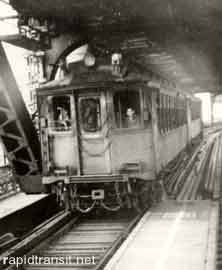
Page 9

A community newspaper, the Bronx Home News, helped organize them. Consequently, opposition to the el's demolition found its voice in this newspaper's vitriolic editorials. Once such piece proclaimed that the Bronx "will not yield up any of the transit facilities which it now possesses without a vigorous fight; a fight that is not merely for a principle but for the first law of nature -- self-preservation." While the language of Queens opposition was legalistic, the language of Bronx opposition was Darwinian. The editorial further claimed that "the retention of the threatened 'L' lines is a matter of grave and direct concern to ALL Bronxites ... If this is to be another case of 'the public be damned,' the Bronx traveling public is not taking the damnation submissively."
Indeed, many Bronx civic associations were not "taking the damnation submissively."
While the First Avenue Association found the el to be of no great benefit to its neighborhood, Queens civic organizations viewed the el as a crucial transportation artery. Not one but several Queens organizations sent the previously quoted resolution to the many political "officials herein enumerated." These eleven civic organizations included those near the Astoria and Flushing Lines, but also included organizations from other Queens neighborhoods, including Bellerose, near the border of Nassau County. Socially, the opposition included property owners, mothers of schoolchildren, and Democratic Party activists. There is no evidence that any organization in Queens supported the el's demolition. Everyone in the borough wanted the el to stay.
Queens Gets a Reprieve
In 1940, the Queens opposition groups were successful. Their resolutions, forwarded to the Transit Commission, had the desired effect. On February 21, 1940, the Transit Commission did not give the city authorization to condemn the entire el, because to do so would be detrimental to Queens. Instead, the Transit Commission approved the condemnation of only part of the el, from 60th Street north to the Harlem River. Trains from Queens could continue to travel to Lower Manhattan via the remaining section of the el, from the Queensboro Bridge at 59 th Street to City Hall.
The Queens organizations' intensive February letter-writing campaign brought a victory -- for the time being.
The Bronx is Not So Lucky
A story of less successful community opposition is that of the Bronx. Residents of the Bronx also used the Second Avenue el to travel to Manhattan and, In 1940, vocal opposition to the el's demolition emerged. Bronx opposition was less well-organized than Queens opposition. Rather than a coordinated lobbying campaign under the auspices of numerous civic organizations across the borough, opposition in the Bronx consisted largely of undirected mass meetings. A 1940 flyer, intended to arouse opposition the el's demolition, unwittingly reveals the uncoordinated nature of Bronx community protest. The flyer read:
DON'T CRAB NEXT MONTH WHEN TRAVEL DOWNTOWN BECOMES UNBEARABLE ... ACT NOW ... ATTEND MASS MEETING PROTESTING PROPOSED DEMOLITION of SECOND AND NINTH AVENUE ELS. at MORRIS HIGH SCHOOL ... YOU MUST DO YOUR SHARE!
The flyer urged citizens to attend a mass meeting in protest. Ultimately, however, such a meeting would be useless, unless the citizens' energy could be directed productively. These mass meetings were not completely uncoordinated.

Queensborough Bridge service was a lifeline for residents of Corona and Flushing who still have no direct rapid transit service to downtown Manhattan.
Updated
©2001 Alexander Nobler Cohen. ©2001 The Composing Stack Inc. All rights reserved